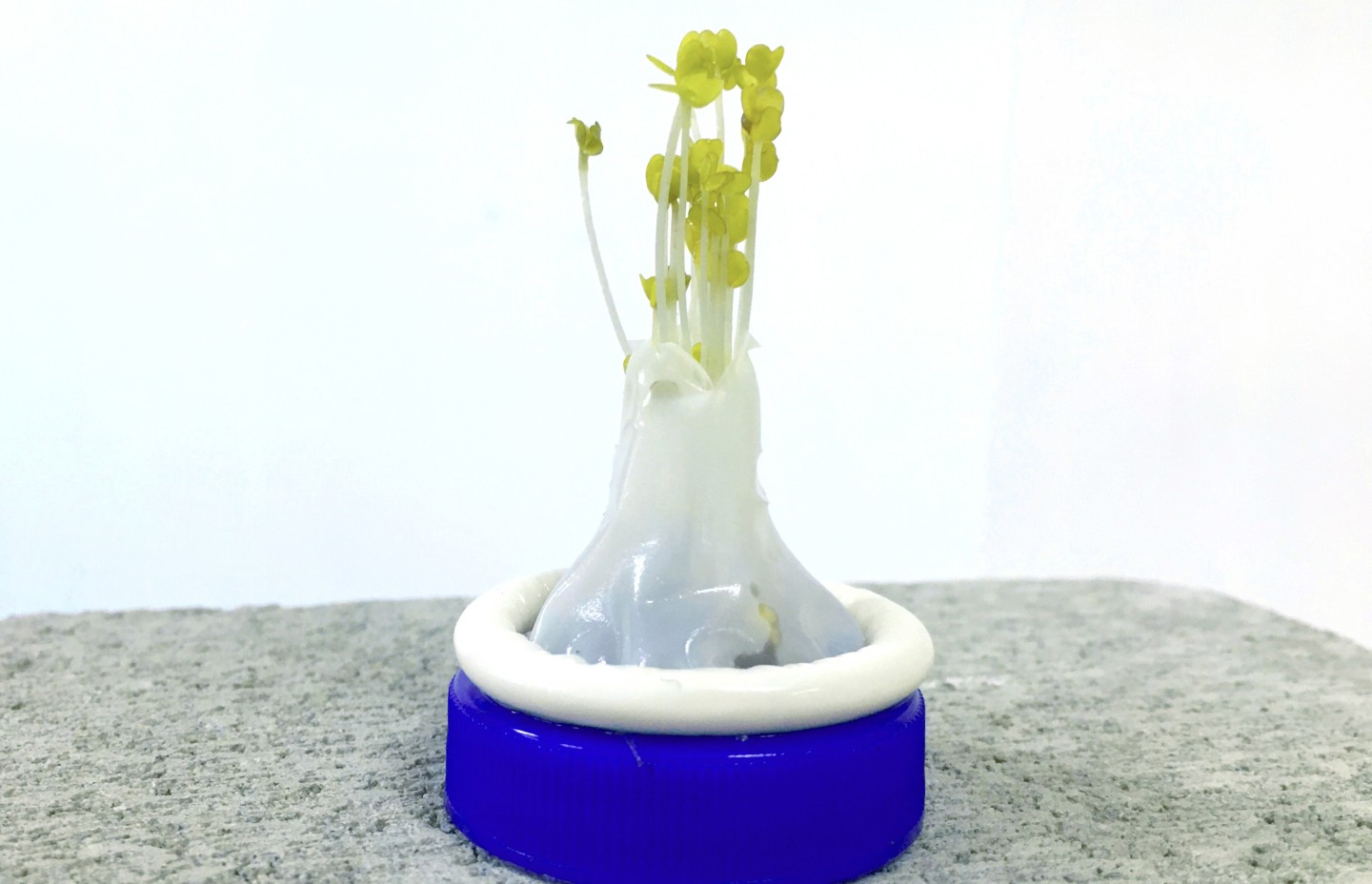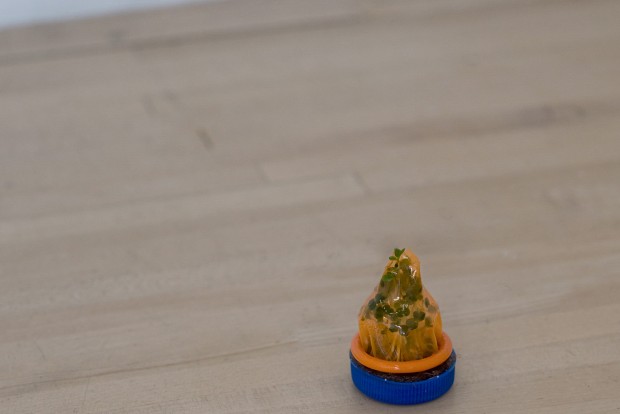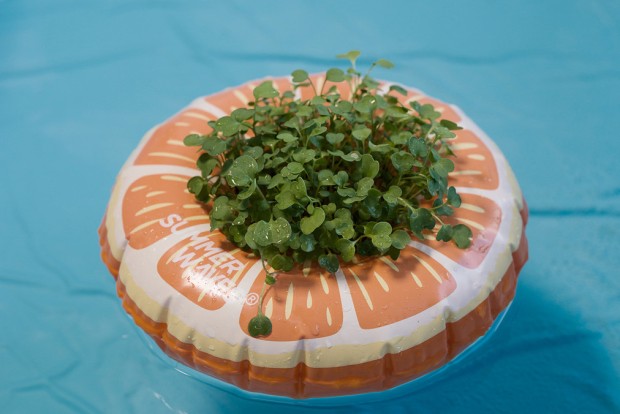
Adam Basanta, Fountain (may 2020), 2020.
Condom, hemp, bottle cap, arugula.
Courtesy of the artist.
Fontaine
Adam Basanta
- Exhibition
Exhibition resulting from the program Autorésidences
Autorésidences is a remote residency program created by the AXENÉO7 artist-run centre in the exceptional context of the COVID-19 pandemic to continue to support research and development of current art practices.
Out of the blue, it is he
Vision to me, bearing leaves
Petals green, covers me in all my shame
— PJ Harvey, lyrics from Fountain (Dry, 1992)
From such a gentle thing, from such a fountain of all delight, my every pain is born.
— Michaelangelo
Fountains — etymologically meaning source or spring, from the latin root “fons” — have been features of human settlements since the bronze-age. Even in antiquity, decorative reservoirs distributed water for populations of early city-states. The urban equivalents of ancient wells, fountains became central gathering places: a location to collect precious drinking water, bathe, and relax. At the same time, these architectural features, designed and financed by ruling elites, function as material reminders of centralized power and the dynamics and responsibilities between social hierarchies.
Advancements in engineering allowed fountains to take advantage of gravity and hydrostatic pressure: water-flow could now burst vertically from the fountainhead, momentarily escaping gravity. A fountain exhibits magical abundance, an endless bubbling source of life and prosperity. Metaphors for fertility, growth, sexuality, and leisure develop further alongside increasingly elaborate sculptural ornamentation.
As modernity approaches, the symbolism of fountains overtakes their original function. Water is no longer accessible for visitors to collect, as they would possess this resource at home. Instead, water becomes an object for aesthetic contemplation, a vehicle through which to visualize control over natural elements, a material with which to explore the human imagination and build powerful narratives.
In these histories, the fountain becomes a lens through which to trace humanity’s ongoing relationship with water, functional design and aesthetics, power and luxury. It is both a projection of symbolic understanding and a resilient reification of such value systems.
What values would a contemporary North American fountain uphold? Water is seemingly limitless and easily available, and simultaneously, a vital agricultural resource in short global supply. In the developed world, it is an affordable luxury for gardens, outdoor activities, sports and enjoyment; elsewhere, it is a cause for anti-privatization protests or war. Water is easily contained in plastic receptacles, which themselves become part of an increasingly distressed oceanic ecosystem as they are discarded.
Fountain presents several improvisational scenarios, each reflecting on these inextricable relationships between water, disposable plastic, agriculture, and leisure; the relationships between human design and irrepressible natural processes. They are unlikely monuments temporarily assembled for no one in particular, performing cycles of inevitable decay and necessary regrowth.
— Adam Basanta
Born in Tel-Aviv (Israel) and raised in Vancouver (Canada), Adam Basanta has lived and worked in Montreal since 2010. Originally studying contemporary music composition, he has developed an artistic practice in mixed-media installations.
Since 2015, his works have been exhibited in galleries and institutions including the Musée des beaux-arts de Montréal (MBAM, Canada), WRO Biennale (Poland), Fotomuseum Winterthur (Switzerland), Cité Internationale des Arts (France), Arsenal Art Contemporain (Canada), Galerie Charlot (France), iMAL (Belgium), National Art Centre, Tokyo (Japan), Moscow Biennale for Young Art (Russia), Carroll/Fletcher Gallery (United-Kingdom), American Medium Gallery (United States of America), Serralves Museum (Portugal), Edith-Russ-Haus für Medienkunst (Germany), York Art Gallery (United-Kingdom), and The Center for Contemporary Arts, Santa Fe (United States of America).
His installations have been awarded prizes in Canada: Prix Pierre Ayot (2019), Sobey Art Award Longlist (2018, 2020), and internationally: Japan Media Arts Prize (2016), Aesthetica Art Prize (2017). He is represented in Canada by Ellephant Gallery (Montreal). His work can be found in the institutional collections of the Musée d’art contemporain de Montreal (MACM), Montreal Fine Arts Museum, the Musée national des beaux-arts du Québec (MNBAQ), the Ville de Montréal, and several corporate collections.









